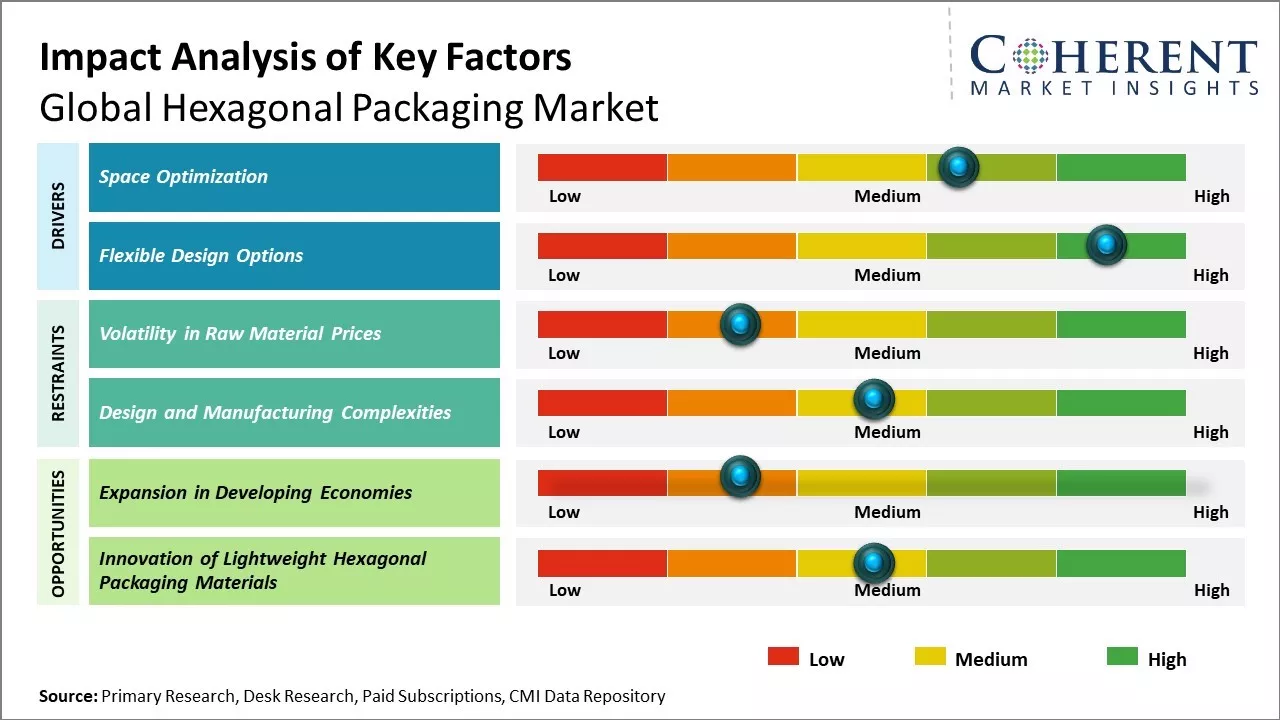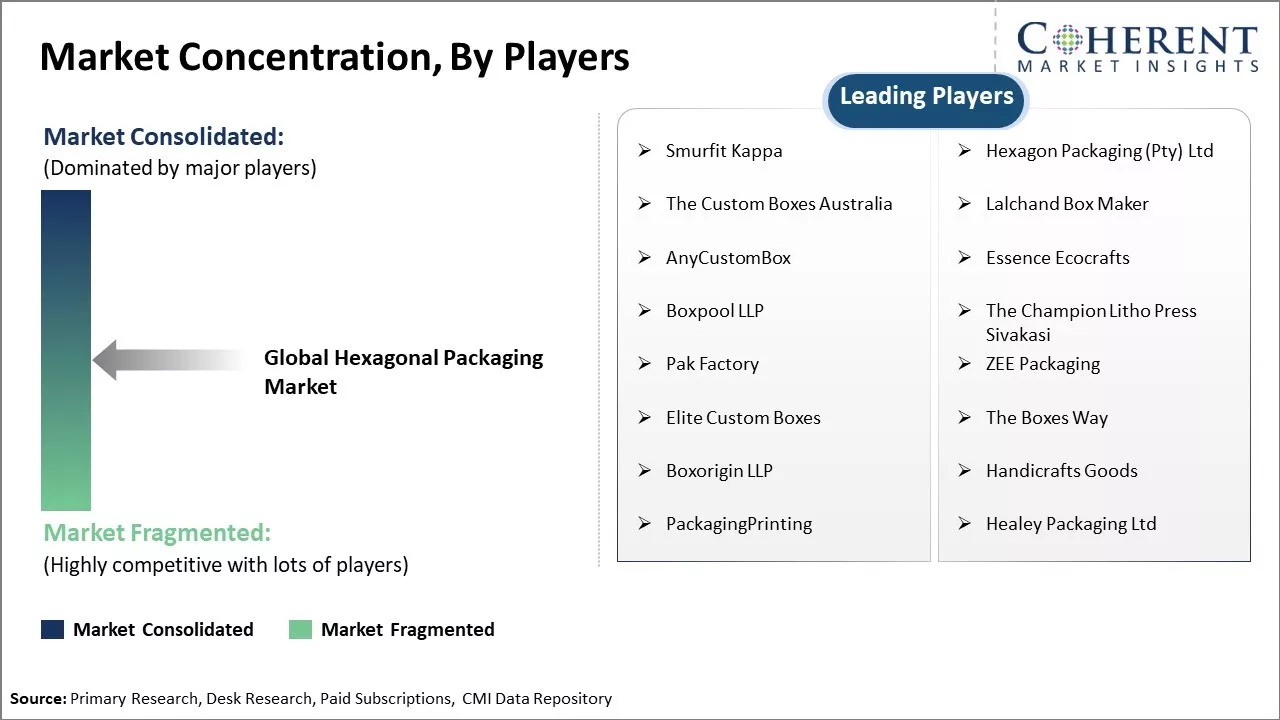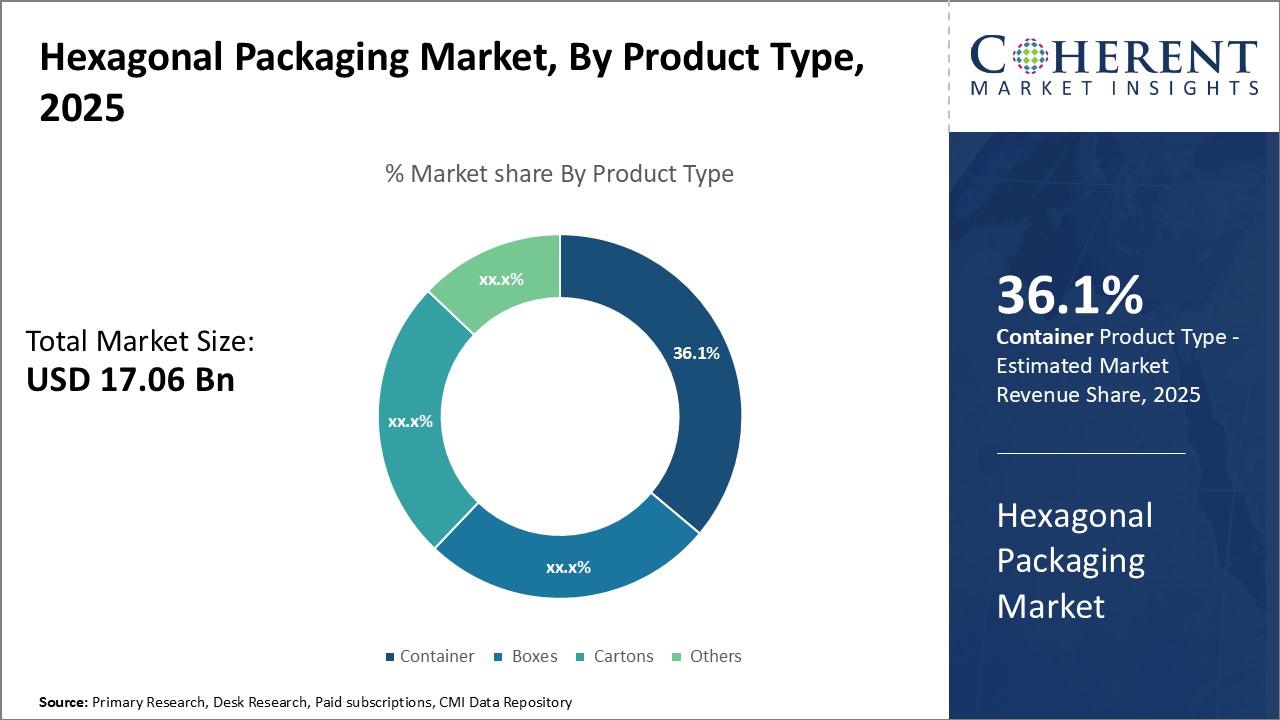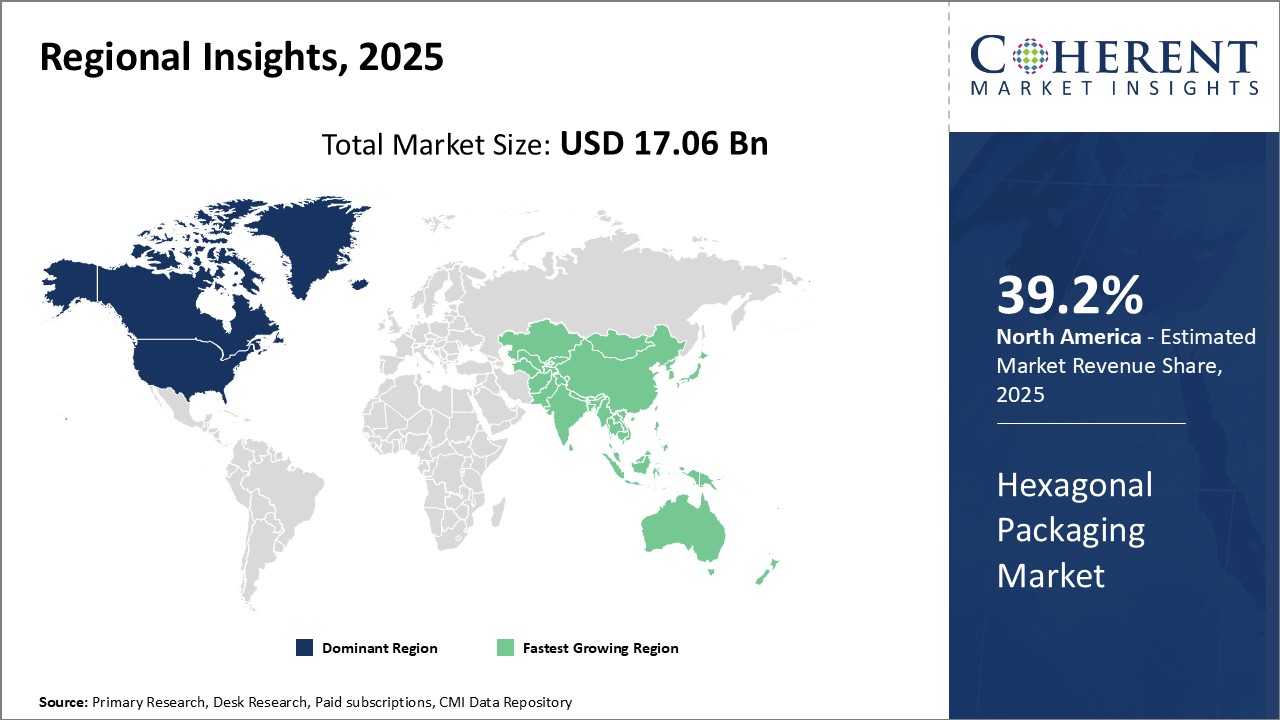Hexagonal Packaging Market Size and Trends
The hexagonal packaging market is estimated to be valued at USD 17.06 Bn in 2025 and is expected to reach USD 26.88 Bn by 2032, growing at a compound annual growth rate (CAGR) of 6.7% from 2025 to 2032.

Discover market dynamics shaping the industry: Download Free Sample
The hexagonal packaging market is expected to witness significant growth over the forecast period. Rising adoption across food and beverage industry where hexagonal packaging provides efficient use of space is driving the market growth. Additionally, increasing focus on sustainable packaging along with the need for rigid and multi-sided containers is further fueling the demand for hexagonal packaging solutions. Preference for this packaging type is high among consumers as it allows easy stacking and transportation of products. Growing e-commerce industry relying on efficient logistics is also contributing to market expansion. Wide application base along with traction gained across industries like consumer goods and industrial goods is expected to push revenues for hexagonal packaging vendors over the coming years.
Space Optimization
Hexagonal shaped packaging utilizes space in an optimal way. Unlike conventional rectangular or square packaging, hexagonal designs maximizes the interior volume relative to the surface area. This allows companies to pack more products in the same shipping container, reducing transportation costs. Hexagonal patterns also leave no gaps between packages, increasing hauling efficiency. These geometric properties offer significant logistical benefits for manufacturers across industries. For food products especially, hexagonal designs open up new opportunities for packaging more contents while using less materials. This improves profit margins for companies. Food processing facilities can load palettes in an optimized hexagonal grid, instead of irregular stacks. The reduced waste translates to lower use of plastics, paperboard, and other resources. Overall carbon footprint is decreased. Moreover, hexagonal boxes interlock together firmly and don't shift during transport. This ensures safety of packaged items and avoids damage. With advancing automation in warehousing, hexagonal shapes are also easier for robots to grasp, lift and organize compared to irregular objects. Warehouse layouts can maximize vertical space utilization through hexagonal stacking. Overall inventory and distribution operations become more streamlined. For companies operating on tight margins or serving low-income customer segments, even small gains in efficiency can make a big difference to profitability and prices. Consumers also benefit from lower retail costs of packaged goods.
Market Concentration and Competitive Landscape

Get actionable strategies to beat competition: Download Free Sample
Flexible Design Options
Unlike rigid rectangular designs, hexagonal packaging accommodates various product dimensions through its versatile shape. Additional cuts and folds enable further customization to exactly fit diverse items. For manufacturers producing an array of SKUs, this single packaging type can be adapted across multiple product lines instead of maintaining separate stock keeping units. This brings down design, tooling and inventory overheads significantly. The hexagon shape also lends itself to multi-cellular or multi-chamber designs through internal partitions or sealed flaps. Multiple same or different products can be packaged together intelligently as per customer needs. Attractive bundled deals and gift packs become possible. Digital printing technologies allow complex graphic designs and information to be directly printed on hexagonal cartons. Vivid colors, images, and messaging help products stand out on shelves amid competition. Additionally, hexagonal windows incorporated on sides or tops showcase contents appealingly without needing to open seals.
Key Takeaways of Analyst:
The hexagonal packaging market is expected to experience steady growth in the coming years. One of the key drivers for this market is the rising demand for optimized packaging from industries like food and consumer goods. Hexagonal designs allow for tighter packing and utilize space more efficiently as compared to conventional circular or square designs. They reduce wastage and lower shipping costs for manufacturers. Another important factor is the increasing focus on sustainable packaging globally. Hexagonal structures are optimized by design to use lesser raw materials while providing similar protection. They produce less wastage during manufacturing as well as after use compared to other shapes.
High costs of machines and molds required for hexagonal packaging production can restrain market growth initially. Established players may also face challenges in transitioning their existing production and supply chains. Furthermore, lack of consumer awareness about benefits can hinder the sales of hexagonal packaged products in price-sensitive developing markets.
Promoting hexagonal packaging as an eco-friendly option. This will help gain ground in regions with stringent environmental regulations like Europe and North America.
Market Challenges: Volatility in Raw Material Prices
The increasing volatility in raw material prices is proving to be a major limiting factor for the expansion of the global hexagonal packaging market. Hexagonal packaging solutions are widely used across numerous industries like food products, beverages, personal care, healthcare and more. These packages are manufactured using various raw materials such as paper, plastic, metal etc. However, the prices of these raw materials have become quite unpredictable in recent years. The Covid-19 pandemic disrupted global supply chains and created huge shortages for many commonly used commodities. This resulted in sharp price fluctuations for materials like paper, resins and metals within a short time frame.
Market Opportunities: Expansion in Developing Economies
Expansion in developing economies has great potential to boost the global hexagonal packaging market going forward. As emerging economies in Asia Pacific, Latin America, Middle East and Africa experience strong economic growth and development over the next decade, their consumption levels and purchasing power will increase substantially. This will lead to higher demand for consumer products as well as electronics, industrial goods and pharmaceuticals which are routinely shipped and stored in hexagonal containers.

Discover high revenue pocket segments and roadmap to it: Download Free Sample
Insights, by Product Type: In terms of product type, containers contribute the highest share due to versatility and protective properties
Container are expected to account for 36.1% share of the hexagonal packaging market in 2025, due to their versatility and protective properties. Hexagonal containers provide significant advantages over traditional circular or rectangular containers. Their unique shape allows for tighter, more efficient packing which maximizes shipping capacity. This reduces transportation costs for manufacturers. Hexagonal containers are also less likely to roll, providing important safety benefits. Their stability makes them well-suited for packing items that could be damaged through movement like electronics or fragile medical equipment. The container segment has grown as brands look to distinguish their products on shelves. Hexagonal containers stand out visually and are easily identifiable compared to competitors. This assists with brand recognition and increases impulse purchases by catching consumers' eyes. Their geometric shape also provides ample blank canvas for creative graphic designs and labeling. As companies invest more in distinctive packaging to attract customers, hexagonal containers are increasingly adopted. While hexagonal containers may have a higher initial production cost, their reusable and durable design lowers long-term expenses. Products arrive undamaged, resulting in less wasted inventory. The secure interlocking containers are easy to assemble, transport and store, speeding up distribution efficiency. Overall hexagonal containers offer superior protection and performance advantages driving their widespread use.
Insights, by End-use Industry: Food and beverage packaging contributed highest due to protective properties and sustainability benefits
The food packaging segment generates the most demand within the hexagonal packaging market with 32.1% share in 2025. Protecting perishable products and extending shelf life are priorities in this industry. Hexagonal containers are well-suited to these needs through their robust construction and tight sealing. Their shape allows for a larger surface area too, displaying product information clearly. This attracts customers' attention on shelves. Additionally, hexagonal shapes are becoming increasingly popular due to their sustainability benefits. Producing interlocking containers minimizes waste during manufacturing. Less raw material is used compared to traditional designs. Hexagonal cartons and boxes are also easier to stack and transport, using fewer pallets and trucks per shipment. This significantly reduces the overall carbon footprint. Growing environmental concerns have motivated brand owners to showcase their green credentials. Hexagonal food packaging displays a company's commitment to sustainability which resonates strongly with ethical consumers. Several major brands have adopted these containers for this reason. As public demand for earth-friendly options rises, the food and beverage segment will continue to drive innovation within the hexagonal packaging market.
Regional Insights

Need a Different Region or Segment? Download Free Sample
North America remains the dominant region in the global hexagonal packaging market. The presence of key players in the region such as Packaging Corporation of America and Smurfit Kappa along with the large packaging material manufacturing base has enabled North America to account for over 39.2% of the global hexagonal packaging demand in 2025. The packaging industry in the region is highly organized and process-oriented, focusing on automation and technology adoption to maximize output. This helps North American brands to effectively meet the packaging needs of different end-use industries, especially food and beverage.
Meanwhile, Asia Pacific has emerged as the fastest growing regional market for hexagonal packaging. Rapid industrialization and growing consumerism have significantly increased packaging consumption across countries like China, India, Japan, and South Korea. Asia Pacific contributes to around a quarter of global hexagonal packaging consumption currently. Price-sensitive local brands prefer hexagonal boxes due to their cost-efficiency over other shapes. Moreover, the presence of several SMEs focusing on FMCG and pharmaceutical products boosts hexagonal packaging usage. Nations like China and India also export large volumes of packaged food, garments, and other products to international markets, thus supporting the hexagonal packaging export growth.
Market Report Scope
Hexagonal Packaging Market Report Coverage
| Report Coverage | Details | ||
|---|---|---|---|
| Base Year: | 2024 | Market Size in 2025: | USD 17.06 Bn |
| Historical Data for: | 2020 To 2024 | Forecast Period: | 2025 To 2032 |
| Forecast Period 2025 to 2032 CAGR: | 6.7% | 2032 Value Projection: | USD 26.88 Bn |
| Geographies covered: |
|
||
| Segments covered: |
|
||
| Companies covered: |
Smurfit Kappa, Hexagon Packaging (Pty) Ltd, The Custom Boxes Australia, Lalchand Box Maker, AnyCustomBox, Essence Ecocrafts, Boxpool LLP, The Champion Litho Press Sivakasi, Pak Factory, ZEE Packaging, Elite Custom Boxes, The Boxes Way, Boxorigin LLP, Handicrafts Goods, PackagingPrinting, and Healey Packaging Ltd |
||
| Growth Drivers: |
|
||
| Restraints & Challenges: |
|
||
Uncover macros and micros vetted on 75+ parameters: Get instant access to report
Hexagonal Packaging Industry News
- In 2024, SOLIZE India and scapos AG Announce Strategic Partnership to Revolutionize Packaging Design
- In 2022, August Sandgren launched newest hexagonal box
*Definition: The hexagonal packaging market involves manufacturing and supplying packaging solutions that utilize hexagonal shapes. Hexagonal containers, boxes, bottles, and other products are ideal for applications where space is limited yet high strength is required. Companies in this market design, test, and produce hexagon-shaped primary and secondary packaging made from materials like paperboard, plastic, and metal. Their products efficiently maximize available area and are commonly used for the food & beverage, consumer goods, industrial goods, and agricultural sectors seeking durable and compact packaging formats.
Market Segmentation
- Product Type Insights (Revenue, USD Bn, 2020 - 2032)
- Container
- Boxes
- Cartons
- Others
- End Use Industry Insights (Revenue, USD Bn, 2020 - 2032)
- Food Packaging
- Cosmetics & Personal Care
- Pharmaceuticals
- Others
- Regional Insights (Revenue, USD Bn, 2020 - 2032)
- North America
- U.S.
- Canada
- Latin America
- Brazil
- Argentina
- Mexico
- Rest of Latin America
- Europe
- Germany
- U.K.
- Spain
- France
- Italy
- Russia
- Rest of Europe
- Asia Pacific
- China
- India
- Japan
- Australia
- South Korea
- ASEAN
- Rest of Asia Pacific
- Middle East & Africa
- GCC Countries
- Israel
- Rest of Middle East & Africa
- North America
- Key Players Insights
- Smurfit Kappa
- Hexagon Packaging (Pty) Ltd
- The Custom Boxes Australia
- Lalchand Box Maker
- AnyCustomBox
- Essence Ecocrafts
- Boxpool LLP
- The Champion Litho Press Sivakasi
- Pak Factory
- ZEE Packaging
- Elite Custom Boxes
- The Boxes Way
- Boxorigin LLP
- Handicrafts Goods
- PackagingPrinting
- Healey Packaging Ltd
Share
Share
About Author
Pankaj Poddar is a seasoned market research consultant with over 12 years of extensive experience in the fast-moving consumer goods (FMCG) and plastics material industries. He holds a Master’s degree in Business Administration with specialization in Marketing from Nirma University, one of India’s reputed institutions, which has equipped him with a solid foundation in strategic marketing and consumer behavior.
As a Senior Consultant at CMI for the past three years, he has been instrumental in harnessing his comprehensive understanding of market dynamics to provide our clients with actionable insights and strategic guidance. Throughout his career, He has developed a robust expertise in several key areas, including market estimation, competitive analysis, and the identification of emerging industry trends. His approach is grounded in a commitment to understanding client needs thoroughly and fostering collaborative relationships. His dedication to excellence and innovation solidifies his role as a trusted advisor in the ever-evolving landscape of not only FMCG but also chemicals and materials markets.
Missing comfort of reading report in your local language? Find your preferred language :
Transform your Strategy with Exclusive Trending Reports :
Frequently Asked Questions
EXISTING CLIENTELE
Joining thousands of companies around the world committed to making the Excellent Business Solutions.
View All Our Clients
